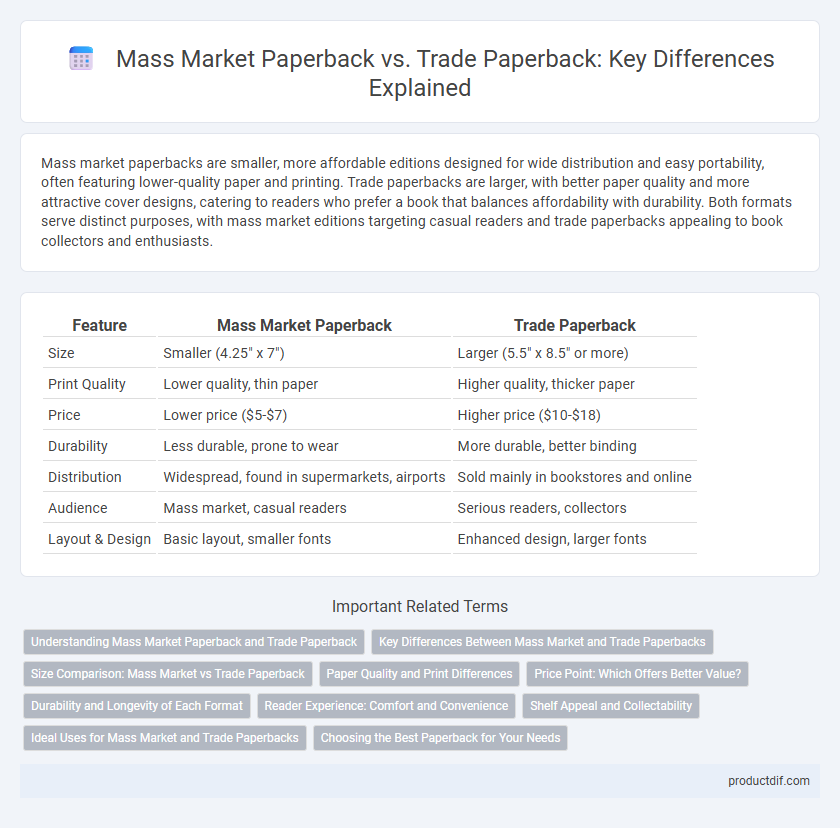Mass market paperbacks are smaller, more affordable editions designed for wide distribution and easy portability, often featuring lower-quality paper and printing. Trade paperbacks are larger, with better paper quality and more attractive cover designs, catering to readers who prefer a book that balances affordability with durability. Both formats serve distinct purposes, with mass market editions targeting casual readers and trade paperbacks appealing to book collectors and enthusiasts.
Table of Comparison
| Feature | Mass Market Paperback | Trade Paperback |
|---|---|---|
| Size | Smaller (4.25" x 7") | Larger (5.5" x 8.5" or more) |
| Print Quality | Lower quality, thin paper | Higher quality, thicker paper |
| Price | Lower price ($5-$7) | Higher price ($10-$18) |
| Durability | Less durable, prone to wear | More durable, better binding |
| Distribution | Widespread, found in supermarkets, airports | Sold mainly in bookstores and online |
| Audience | Mass market, casual readers | Serious readers, collectors |
| Layout & Design | Basic layout, smaller fonts | Enhanced design, larger fonts |
Understanding Mass Market Paperback and Trade Paperback
Mass market paperbacks are smaller, portable books printed on lower-quality paper, typically sold in wide retail outlets like supermarkets and airports, designed for affordability and high-volume sales. Trade paperbacks are larger, often with better-quality paper and more durable covers, usually matching hardcover editions in size and sold primarily in bookstores. Both formats cater to different reader preferences and price points, with mass market paperbacks focusing on accessibility and trade paperbacks emphasizing a premium reading experience.
Key Differences Between Mass Market and Trade Paperbacks
Mass market paperbacks are smaller, more affordable editions primarily found in non-traditional book retail outlets, featuring lower-quality paper and compact dimensions around 4.25" x 6.87". Trade paperbacks are larger, measuring approximately 5.5" x 8.5" or more, printed on higher-quality paper with better formatting, typically sold in bookstores and designed for durability and ease of reading. The key differences include size, paper quality, price point, and target market, with mass market editions aimed at broad, budget-conscious audiences and trade paperbacks geared toward readers seeking enhanced reading experiences.
Size Comparison: Mass Market vs Trade Paperback
Mass market paperbacks typically measure around 4.25 x 6.87 inches, making them smaller and more compact compared to trade paperbacks, which generally range from 5.5 x 8.25 to 6 x 9 inches. The larger size of trade paperbacks allows for better print quality, larger fonts, and more spacious layouts, enhancing the reading experience. Size differences also impact pricing, with mass market paperbacks often being less expensive due to their smaller dimensions and lower production costs.
Paper Quality and Print Differences
Mass market paperbacks typically use lower-quality, thinner paper with smaller print size, designed for affordability and portability. Trade paperbacks feature higher-quality, thicker paper and larger, clearer print, offering enhanced durability and a more comfortable reading experience. The difference in paper weight and print clarity contributes significantly to the overall price and tactile feel between mass market and trade paperback editions.
Price Point: Which Offers Better Value?
Mass market paperbacks typically offer a lower price point, making them more affordable and accessible for casual readers or those on a budget. Trade paperbacks, while slightly more expensive, provide better value through higher quality paper, larger print, and enhanced durability, appealing to readers seeking a longer-lasting book. Evaluating price versus quality helps determine which format aligns better with a reader's priorities and spending habits.
Durability and Longevity of Each Format
Mass market paperbacks feature lower-quality, thinner paper and weaker glue binding, making them less durable and prone to wear, creasing, and spine damage over time. Trade paperbacks utilize sturdier paper stock and stronger bindings, offering greater longevity and resistance to physical damage, ideal for collectors and long-term use. The enhanced durability of trade paperbacks comes with a higher production cost, but ensures prolonged usability compared to mass market editions.
Reader Experience: Comfort and Convenience
Mass market paperbacks offer readers exceptional portability and affordability, making them ideal for on-the-go reading and budget-conscious consumers. Trade paperbacks, with their larger size and higher-quality paper, provide a more comfortable reading experience through easier-to-handle layouts and clearer text. Both formats enhance accessibility, but trade paperbacks tend to reduce eye strain and improve durability for extended reading sessions.
Shelf Appeal and Collectability
Mass market paperbacks feature smaller dimensions and lower-quality paper, offering high shelf appeal in crowded retail settings but limited collectability due to their fragile nature. Trade paperbacks, larger with better-quality materials, provide greater visual impact on shelves and are favored by collectors for their durability and aesthetic value. Collectors prioritize trade paperbacks for first editions and unique cover art, enhancing long-term shelf appeal beyond initial retail display.
Ideal Uses for Mass Market and Trade Paperbacks
Mass market paperbacks are ideal for popular fiction, genre novels, and inexpensive, portable reading, making them perfect for commuters and casual readers seeking affordability and convenience. Trade paperbacks suit literary fiction, nonfiction, and academic works, offering higher quality paper and larger formats that enhance readability and durability for collectors and serious readers. Choosing between the two depends on priorities like cost, format size, and target audience engagement.
Choosing the Best Paperback for Your Needs
Mass market paperbacks offer affordability and compact size, ideal for casual readers on the go, while trade paperbacks provide higher quality paper and larger dimensions for enhanced readability and durability, appealing to collectors and serious readers. Choosing the best paperback depends on your preferences: prioritize mass market editions for lower cost and portability or select trade paperbacks for a more premium reading experience with better aesthetics. Consider factors like budget, reading habits, and long-term book care to decide between mass market and trade paperback formats.
Mass Market Paperback vs Trade Paperback Infographic

 productdif.com
productdif.com